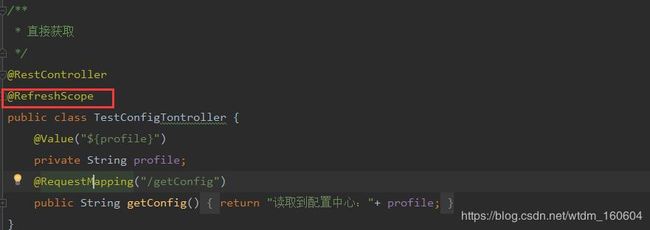SpringCloud Config(配置中心)实现配置自动刷新总结
一、实现原理
1、ConfigServer(配置中心服务端)从远端git拉取配置文件并在本地git一份,ConfigClient(微服务)从ConfigServer端获取自己对应 配置文件;
2、当远端git仓库配置文件发生改变,ConfigServer如何通知到ConfigClient端,即ConfigClient如何感知到配置发生更新?
Spring Cloud Bus会向外提供一个http接口,即图中的/bus/refresh。我们将这个接口配置到远程的git的webhook上,当git上的文件内容发生变动时,就会自动调用/bus-refresh接口。Bus就会通知config-server,config-server会发布更新消息到消息总线的消息队列中,其他服务订阅到该消息就会信息刷新,从而实现整个微服务进行自动刷新。
二:实现方式
实现方式一:某个微服务承担配置刷新的职责
1、提交配置触发post调用客户端A的bus/refresh接口
2、客户端A接收到请求从Server端更新配置并且发送给Spring Cloud Bus总线
3、Spring Cloud bus接到消息并通知给其它连接在总线上的客户端,所有总线上的客户端均能收到消息
4、其它客户端接收到通知,请求Server端获取最新配置
5、全部客户端均获取到最新的配置
存在问题:
1、打破了微服务的职责单一性。微服务本身是业务模块,它本不应该承担配置刷新的职责。2、破坏了微服务各节点的对等性。3、有一定的局限性。WebHook的配置随着承担刷新配置的微服务节点发生改变。
改进如下方式二:配置中心Server端承担起配置刷新的职责,原理图如下:
1、提交配置触发post请求给server端的bus/refresh接口
2、server端接收到请求并发送给Spring Cloud Bus总线
3、Spring Cloud bus接到消息并通知给其它连接到总线的客户端
4、其它客户端接收到通知,请求Server端获取最新配置
5、全部客户端均获取到最新的配置
三:实现步骤
基本步骤:1、添加依赖 2、修改配置文件 3、添加注解
备注:这里给出方式二配置方法,方式一的区别在:因为是某个微服务承担配置刷新的职责,所以Server端不需要配置 Rabbitmq和添加bus-amqp的依赖。
<一>Config Server端配置(提前安装rabbitmq移步链接:)
1、添加依赖
org.springframework.cloud
spring-cloud-config-server
org.springframework.cloud
spring-cloud-starter-bus-amqp
2、修改配置文件Bootstrap.yml文件
server:
port: 9090
spring:
application:
name: config-server
cloud: #config服务端,从git拉取数据
config:
server:
git:
uri: https://github.com/****/config-repo # 配置git仓库的地址
username: # git仓库的账号
password: # git仓库的密码
search-paths: /*/*/*,/* #仓库下配置文件搜索路径
rabbitmq: #本地环境不需要配置mq,但是需要启动mq,Springboot会自动连接本地mq
host: localhost
port: 5672
username: guest
password: guest
eureka: #注册服务
client:
serviceUrl:
defaultZone: http://localhost:8761/eureka/
#defaultZone: http://localhost:8761/eureka/,http://localhost:8762/eureka/ #eureka高可用
management: #SpringCloud 1.5版本暴露接口,暴露/bus-refresh接口
security:
enabled: false
# endpoints: #SpringCloud 2.0.0版本以后暴露接口方式
# web:
# exposure:
# include: "*"
security: #是否开启基本的鉴权,默认为true
basic:
enabled: false备注:关于git仓库配置那块,参考这篇博客:http://www.cnblogs.com/hellxz/p/9306507.html
本地环境不需要配置mq,但是需要启动mq,Springboot会自动连接本地mq,后面客户端也是,如果是线上环境的话,必须要进行配置,原因看看SpringCloud bus如下说明:
3、启动类增加注解 @EnableConfigServer
至此Config-Server端已配置完毕
<二>Config Client端配置
1、添加依赖
org.springframework.cloud
spring-cloud-starter-config
org.springframework.cloud
spring-cloud-starter-bus-amqp
org.springframework.boot
spring-boot-starter-actuator
2、修改配置文件Bootstrap.yml文件
server:
port: 9092
spring:
application:
name: config-client #对应微服务配置文件名称
cloud:
config:
uri: http://localhost:9090/ #config server 端地址
profile: dev #项目配置文件选择
label: master #git仓库的分支
discovery:
enabled: true
service-id: config-server #config-server服务名称
rabbitmq: #本地环境不需要配置mq
host: localhost
port: 5672
username: guest
password: guest
security: #
basic:
enabled: false3、添加注解: @RefreshScope添加在需要刷新的配置文件上
注明:自动刷新只能刷新 @RefreshScope 注解下的配置,一些特殊配置,如数据库等,需要同样先设置数据库链接ConfigServer类,然后通过加 @RefreshScope 注解方式
到这里Config-Server端和Client端已经配置完毕,先后启动Server端和Client端,post请求方式进行测试:http://localhost:9090/bus/refresh
<三>配置git的webhook
前面已准备就绪,启动Server端和Client端,要实现配置自动刷新需要调用/bus-refresh接口通知config-Server
方式一:手动调用(post请求):http://localhost:9090/bus/refresh(Server端地址)
方式二:配置git的webhook ,当git端配置发生改变,自动调用/bus-refresh接口
![]()
<四>附件
config-client-dev.yml配置文件:
spring:
datasource:
type: com.alibaba.druid.pool.DruidDataSource
url: jdbc:mysql://127.0.0.1:3306/test_mybatis_db?autoReconnect=true&useSSL=false&useUnicode=true&characterEncoding=UTF-8
username: root
password: 1234
driverClassName: com.mysql.jdbc.Driver
druid:
initialSize: 5
minIdle: 5
maxActive: 20
maxWait: 60000
timeBetweenEvictionRunsMillis: 60000
minEvictableIdleTimeMillis: 300000
validationQuery: SELECT 1
testWhileIdle: true
filters: stat,wall,log4j
mybatis:
type-aliases-package: com.scnu.springcloudconfigclient.domain
mapper-locations: classpath*:mapper/*.xml
eureka: #注册服务
client:
serviceUrl:
defaultZone: http://localhost:8761/eureka/
custom:
username: guest-new
passwd: guest-new
profile: test-new<五>加解密
引入:配置文件统一放在配置中心,配置中心文件明文存在不安全,容易泄露比如数据库用户名、密码等,如何实现git仓库配置文件为密文时,通过配置中心在Config-Server端进行解密。
<一>对称加密
1、JCE加密,Oracl官网下载,替换本机JDK下JRE的lib下在两个文件。
https://www.oracle.com/technetwork/java/javase/downloads/jce-all-download-5170447.html
2、
a) Config-Server 端配置文件添加:
encrypt: #加密因子
key: foobar加密因子为foobar,这里借助了Server端的加密,因此配置完毕需要启动Config-Server
b) 启动Config-Server
$ curl -X post http://localhost:9090/encrypt -d mysecret
加密mysecret为密码,得到如下加密字串:
682bc583f4641835fa2db009355293665d2647dade3375c0ee201de2a49f7bda
c) 逆向操作:
$ curl -X post http://localhost:9090/decrypt -d 682bc583f4641835fa2db009355293665d2647dade3375c0ee201de2a49f7bda
解密得到:
mysecret
3、使用:
a) Config-Server端配置文件中加入:
encrypt: #加密因子foobar
key: foobar
b) Git仓库中配置文件caiyun-test-dev.yml
profile: '{cipher}682bc583f4641835fa2db009355293665d2647dade3375c0ee201de2a49f7bda'
备注:.properties文件吧引号去掉
c) Config-client不需要做任何操作
<二>非对称加密
RSA算法
1、命令行下执行
$ keytool -genkeypair -alias mytestkey -keyalg RSA -dname "CN=Web Server,OU=Unit,O=Organization,L=City,S=State,C=US" -keypass changeme -keystore server.jks -storepass letmein
执行完生成 server.jks 文件,加密文件
2、将Server.jks 文件放在Config-Server的ClassPass路径下,
Config-Server 端配置文件bootstrap.yml中添加:
encrypt:
keyStore:
location: classpath:/server.jks #生成在jks文件路径
password: letmein #key store 秘钥
alias: mytestkey #别名
secret: changeme #私钥启动Config-Server
3、加密
$ curl -X post http://localhost:9090/encrypt -d caiyun-mima
加密caiyun-mima,得到如下加密字串:
682bc583f4641835fa2db009355293665d2647dade3375c0ee201de2a49f7bda
4、使用:
a)Config-Server端配置文件中加入:
encrypt:
keyStore:
location: classpath:/server.jks #生成在jks文件路径
password: letmein #key store 秘钥
alias: mytestkey #别名
secret: changeme #私钥 b) Git仓库中配置文件caiyun-test-dev.yml
profile: '{cipher}682bc583f4641835fa2db009355293665d2647dade3375c0ee201de2a49f7bda'
备注:.properties文件吧引号去掉
c) Config-client不需要做任何操作
项目Demo代码见github:





